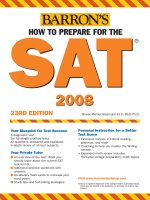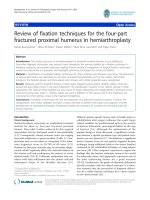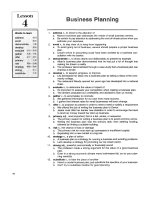review of math topics for the sat phần 2 doc
Bạn đang xem bản rút gọn của tài liệu. Xem và tải ngay bản đầy đủ của tài liệu tại đây (401.55 KB, 10 trang )
3/6 (since we now have 3 orange candies and a total of 6 candies left). So the probability of
withdrawing two orange candies in a row is
4 x 3 = 12 = 2
7 6 42 7
I. EXPONENTS AND RADICALS
1. Multiplying and Dividing Powers
To multiply powers with the same base, add the exponents and keep the same base:
3 4 3+4 7
b X b = b = b
To divide powers with the same base, subtract the exponents and keep the same base:
12 8 12-8 4
b / b = b = b
2. Raising Powers to Powers
To raise a power to a power, multiply the exponents:
3 5 3x5 15
(x ) = x = x
3. Negative Powers
A number raised to a negative exponent is simply the reciprocal of that number raised to the
corresponding positive exponent.
-3
2 = 1 = 1
3 8
2
4. Simplifying Square Roots ________
V
To simplify a square root, factor out the perfect squares under the radical, unsquare them and put
the result in front:
__ ____ __ __ ___
V12 = V 4X3 = V 4 X V 3 = 2 V 3
5. Adding and Subtracting Roots
You can add or subtract radical expressions when the part under the radicals is the same:
__ __ ___
2 V7 + 3 V7 = 5 V7
Don't try to add or subtract when the radicals are different. You cannot simplify expressions like:
___ __
2 V 3 + 3 V 5
6. Multiplying and Dividing Roots
The product of square roots is equal to the square root of the product:
__ __ ______ ___
V 2 x V 3 = V 2 X 3 = V 6
The quotient of square roots is equal to the square root of the quotient:
__ ___ ____ ___
V 8 / V 2 = V 8/4 = V 2
J. ALGEBRAIC EXPRESSIONS
1. Evaluating an Expression
To evaluate an algebraic expression, plug in the given values for the unknowns and calculate
according to the rules for the order of operations.
2
Example: To find the value of x + 3x - 1 when x = -2, plug in -2 for x:
(-2)(-2) + 3(-2) - 1 = 4 -6 -1 = -3.
2. Adding and Subtracting Monomials
To combine like terms, keep the variable unchanged while adding or subtracting the
coefficients: 9a + 4a = (9 + 4)a = 13a
3. Adding and Subtracting Polynomials
To add or subtract polynomials, combine like terms.
2 2 2 2 2
(3x + 5x -7) - (x + 12) = (3x - x ) +5x + (-7 -12) = 2x + 5x - 19
4. Multiplying Monomials
To multiply monomials, multiply the coefficients and the variables separately:
2
2a x 3a = (2 x 3)(a x a) = 6a
5. Multiplying Binomials
To multiply binomials such as (x + 2) (x + 3), use the following order:
2
a) First multiply the first terms: x times x = x
b) Next multiply the outer terms: x times 4= 4x.
c) Then multiply the inner terms: 3 times x = 3x.
d) Last, multiply the last terms: 3 times.4 = 12.
2 2
Then, add and combine like terms: x + 4x + 3x + 12 = x + 7x + 12
6. Multiplying Other Polynomials
To multiply polynomials with more than two terms, make sure you multiply each term in the first
polynomial by each term in the second.
2
(x + 3x + 4) times (x + 5) =
2
x (x + 5) + 3x (x + 5) + 4 (x + 5) =
3 2 2
x + 5x + 3x + 15x + 4x + 20 =
3 2
x + 8x + 19x + 20
After multiplying two polynomials together, the number of terms in your expression before
simplifying should equal the number of terms in one polynomial multiplied by the number of terms in
the second. In the example above, you should have 3 X 2 = 6 terms in the product before you
simplify like terms.
K. FACTORING ALGEBRAIC EXPRESSIONS
1. Factoring the Difference of Squares
One of the test maker's favorite factorables is the difference of squares.
2 2
a - b = (a -b) (a + b)
2
a - 9, for example, factors to (a - 3)(a + 3).
2. Factoring the Square of a Binomial
Learn to recognize polynomials that are squares of binomials:
2 2
a + 2ab + b = (a + b)
2 2
a - 2ab + b = (a -b)
2 2 2 2
For example, 4x + 12x + 9 factors to (2x + 3), and n - 10n + 25 factors to (n -5).
3 . Simplifying an Algebraic Fraction
Simplifying an algebraic fraction is a lot like simplifying a numerical fraction: find factors common to
the numerator and denominator and cancel them.
Take the rather cumbersome expression:
2
a + 7a + 12
____________
2
a - 9
2
a + 7a + 12 = (a + 3) (a + 4)
2
a - 9 = (a + 3) (a - 3)
Thus, we can cancel out the identical expressions (a + 3) in the numerator and denominator,
leaving us with (a + 4) (a - 3).
L. SOLVING EQUATIONS
1. Solving a Linear Equation
To solve an equation, isolate the variable. For the equation: 4x -12 = -3x + 9, first get all the xs
on one side by adding 3x to both sides: 7x -12 = 9. Then add 12 to both sides: 7x = 21. Then
divide both sides by 7: x = 3.
2. Solving "In Terms Of Another Variable"
To solve an equation for one variable in terms of another, isolate one variable on one side of the
equation, leaving an expression containing the other variable on the other side of the equation.
To solve the equation 6x - 9y = 10x + 3y for x in terms of y, isolate x:
6x - 9y = 10x + 3y
6x = 10x + 12y
-4x =12y
x = -3y
3. Solving a Quadratic Equation
To solve a quadratic equation, follow these steps:
2
a) Arrange the equation in the form: "ax + bx + c = 0"
b) Factor the left side
c) Set each factor equal to 0 separately to get the two solutions.
2 2
To solve x + 12 = 7x, first rewrite it as x - 7x+ 12 = 0 Then factor the left side:
(x -3)(x -4) = 0
x - 3 = 0 or x - 4 = 0
X = 3 or 4
4. Solving a System of Equations
You can solve for two variables only if you have two distinct equations. Combine the equations to
cancel out one of the variables.
To solve the two equations 4x + 3y = 8 and x + y = 3, multiply both sides of the second
equation by -3 to get: -3x -3y = -9. Now add the two equations; the 3y and the -3y cancel out,
leaving: x = -1. Plug that back into either one of the original equations to determine that y = 4.
6. Solving an Inequality
To solve an inequality, isolate the variable. Just remember that when you multiply or divide both
sides by a negative number, you must reverse the sign. To solve -5x + 7 < -3, subtract 7 from both
sides to get: -5x < -10. Now divide both sides by -5, remembering to reverse the sign: x > 2.
M. WORD PROBLEMS
Word problems account for a significant portion of the questions on the exam. They test the same
concepts as other test questions (algebra, math, geometry), but require the additional step of
translating the situation from ordinary language to mathematical terms.
A typical algebra problem might have the equation 3b = f - 5.
In a word problem, this translates to: If Beth had three times as many candy bars, she would have
four candy bars less than Francesca.
To translate from words into algebra, look for the key words and phrases that you must turn into
algebraic expressions. Here are the most typical conversions:
Concept Symbol Words Example Translation
Equality = is 2 plus 3 is 5 2 + 3 = 5
equals c minus 2 equals 5 c - 2 = 5
is the same as
Addition + plus x plus z equals n x + z = n
add J adds x to 13 x + 13 = J
increase n is increased by 3% n + 0.03n
Subtraction - minus x minus y x - y
difference
Multiplication x times
product of x is 125% of y x = 125%y
Division / quotient
dividend x divided by y is 4 x/y = 4
Here are several examples of converting english into algebra:
a) Beth gets 4 dollars more than twice Amy's salary: B = 4 + 2A
b) A quarter of the sum of a and b is 4 less than a: 0.25(a+ b) = a - 4
c) If $200 is taken from Jake's salary, then the combined salaries of Jake and Kate will be double
what Jake's salary would be if it was increased by one third of itself:
J - 200 + K = 2 (J + J/2)
d) Tara's age is 5 years less than twice Jade's age and the sum of their ages is 16:
(let x = Jade's age)
(2x - 5) + x = 16
The most difficult part of a word problem is correctly translating words to an algebraic equation.
Here are our best tips for approaching word problems:
1) First, choose a variable to stand for the least unknown quantity and then write the other unknown
quantities in terms of that variable.
2) Second, write an equation based on the situation given. Most test problems pivot on two
quantities being equal.
3) Solve the equation and interpret the result.
Examples:
1) A certain book costs $12 more in the local retail bookstore than on Amazon.com. If Amazon's
price is 2/3 of the retail price, how much does the book cost retail?
Solution: We are told to determine the retail price, R.
From the narrative, we know that:
Retail Price R = Amazon price + 12, or R = 2/3 R + 12
Solving for R, we find that the retial price is $36.00
2) During a spill the amount of milk in a tank was reduced by a third. If the amount of milk in the
tank was 48,000 gallons immediately after the spill, how many gallons of milk were lost during the
spill?
Solution: We are told that one third of the milk was spilled, leaving 48,000 gallons. Let M equal the
total amount originally in the tank:
M - 1/3 (M) = 48,000
M = 72,000
The amount lost is 1/3 of 72,000, or 24,000 gallons
3) An restaurant has 27 employees. If there are seven more waitresses than managers, how many
employees are waitresses?
Solution: Let W be the number of waitresses, which is what we are being asked to calculate. We
know that the number of waitresses plus the number of managers = 27. We also know there are 7
more waitresses than managers. This translates to:
Managers + 7 = W or Managers = W - 7
Substitute this into the first equation to get:
(W - 7) + W = 27
Solving for W, we find W = 17. There are 17 waitresses in the restaurant and 10 managers, totalling
27 employees.
One advantage to the test problems is that the correct answer will ALWAYS be listed as one of
your answer choices.
N. COORDINATE GEOMETRY
1. Plotting a Point on the xy Plane
Points in the xy-plane are represented by two numbers called coordinates:
a) The first number in the pair is the x-coordinate, which is is the horizontal distance of the point
from the origin, which is point (0,0). Points with positive x-coordinates are to the right of the y-axis.
Points with negative x-coordinates are to the left of the y-axis.
b) The second number is the y-coordinate, which is the vertical distance from the origin. Points
with positive y- coordinates are above the x-axis. Points with negative y-coordinates are below the
x-axis.
c) A point is represented by the ordered pair (x, y). x is called the abscissa and y is called the
ordinate.
2) Finding the Distance Between Two Points
To find the distance between points on a graph, use the Pythagorean theorem for special right
triangles. The difference between the x's is one leg and the difference between the y's is the other.
Example: Two points on a graph are P (-2, 2) and Q (1,-2). The distance between them is actually
the hypotenuse of a 3-4-5 right triangle. Delta X is 3, Delta y is 4, hence, the distance PQ = 5.
We could also solve this by using the distance formula:
___________________
/ 2 2
Distance = V (x1 -x2) + (y1 - y2)
Example: A line segment is drawn from the point (3, 5) to the point (9, 13). What are the
coordinates of the midpoint of this line segment?
Solution: Add the x values and divide by two. (3 + 9) / 2 = 6. Then, add the y values and divide
by two (5 + 13) / 2 = 9. Thus, the coordinates of the midpoint of the line are (6, 9).
3) Using Two Points to Find the Slope
Slope = Change in y = Rise
Change in x Run
The slope of the line that contains the points A (2, 3) and B (0, -1) is:
(y2 - y1) / (x2 - x1) = (-1 - 3) / (0 - 2) = -4 / -2 = 2
4. Using an Equation to Find the Slope
To find the slope of a line from an equation, put the equation into the slope-intercept form:
y = mx + b
The slope is m and the y-intercept is b. To find the slope of the equation 3x + 2y = 4, rearrange it:
3x + 2y = 4
2y = -3x + 4
y = -3/2 x + 4
The slope is -3/4
5) Using an Equation to Find an Intercept
To find the y-intercept, either:
a) put the equation into y = mx + b (slope-intercept) form, in which in which case b is the
y-intercept
b) plug x = 0 into the equation and solve for y.
To find the x-intercept, plug y = 0 into the equation and solve for x.
O. LINES AND ANGLES
1) Intersecting Lines
When two lines intersect, four angles are formed. Adjacent angles are supplementary
and vertical angles are equal.
a = b, and c = d
Vertical Angles: those opposite each other; are always equal
Straight Angles: has its sides lying along a straight line; is always equal to 180 degrees
Adjacent Angles: two angles are adjacent if they share the same vertex and a common side, but
no angle is inside another angle.
Supplementary Angles: if the sum of two angles is a straight line (180 degrees), the two angles are
supplementary and each angle is the supplement of each other
Right Angles: if two supplementary angles are equal, they are both right angles. A right angle is
half of a straight line and measures exactly 90 degrees.
Complementary Angles: two angles whose sum is 90 degrees
Acute Angles: those whose measure is less than 90 degrees
Obtuse Angles: those whose measure is greater than 90 degrees but less than 180 degrees
2) Parallel Lines and Transversals
A transversal across parallel lines form four equal acute angles and four equal obtuse angles.
Line 1
Line 2
In the figure above, the top line (line 1) is parallel to the bottom line (line 2).
Angles a, c, e and g are obtuse, so they are all equal.
Angles b, d, f and h are acute, so they are all equal.
In addition, each of the acute angles is supplementary to each of the obtuse angles.
Angles a and h are supplementary, as are b and e, c and f, and so on.
P. Triangles
1) Interior Angles of a Triangle
The three interior angles of any triangle add up to 180 degrees
In the figure above, x + 50 + 100 = 180, so x = 30.
Example: In triangle XYZ, angle Y is twice angle X and angle Z is 40 degrees more than angle Y.
How many degrees are in the three angles?
Solution: Knowing that the three angles must total 180 degrees, solve this using an algebraic
equation. Let x = angle X, 2x = angle Y, and 2x + 40 = angle Z:
x + 2x + (2x + 40) = 180. Solving for X, we find that:
Angle X = 28 degrees Angle Y = 56 degrees Angle Z = 96 degrees









